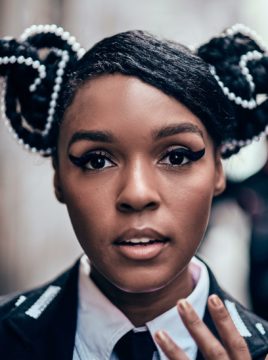Michael Schulman at The New Yorker:
 So who is Janelle Monáe? Since she emerged on the music scene, she’s been less a pop star than a world-builder, refracting herself through sci-fi and Afrofuturist imagery. Her first EP, “Metropolis: The Chase Suite,” from 2007, drew on Fritz Lang’s German Expressionist classic and cast Monáe as her android alter ego, Cindi Mayweather. With her tuxedos and protruding pompadours, she was a glam retro-futurist androgyne, and her three studio albums—“The ArchAndroid” (2010), “The Electric Lady” (2013), and “Dirty Computer” (2018)—leaned into her funk-robot persona. “I’m a cyber-girl without a face, a heart, or a mind,” she sang on one track. Monáe used Mayweather and other spinoff characters as metaphors for her sense of otherness, as a queer Black woman from Kansas City, Kansas. (In 2018, she came out as pansexual, and last April revealed herself to be nonbinary; she uses she/her or they/them pronouns but says that her preferred pronoun is “freeassmuthafucka.”) Monaé’s forty-eight-minute visual album—or “emotion picture”—for “Dirty Computer” featured her as Jane 57821, a Sapphic android in a “Blade Runner”-esque dystopia, and in 2022 she expanded the “Dirty Computer” universe into a sci-fi story collection, “The Memory Librarian.”
So who is Janelle Monáe? Since she emerged on the music scene, she’s been less a pop star than a world-builder, refracting herself through sci-fi and Afrofuturist imagery. Her first EP, “Metropolis: The Chase Suite,” from 2007, drew on Fritz Lang’s German Expressionist classic and cast Monáe as her android alter ego, Cindi Mayweather. With her tuxedos and protruding pompadours, she was a glam retro-futurist androgyne, and her three studio albums—“The ArchAndroid” (2010), “The Electric Lady” (2013), and “Dirty Computer” (2018)—leaned into her funk-robot persona. “I’m a cyber-girl without a face, a heart, or a mind,” she sang on one track. Monáe used Mayweather and other spinoff characters as metaphors for her sense of otherness, as a queer Black woman from Kansas City, Kansas. (In 2018, she came out as pansexual, and last April revealed herself to be nonbinary; she uses she/her or they/them pronouns but says that her preferred pronoun is “freeassmuthafucka.”) Monaé’s forty-eight-minute visual album—or “emotion picture”—for “Dirty Computer” featured her as Jane 57821, a Sapphic android in a “Blade Runner”-esque dystopia, and in 2022 she expanded the “Dirty Computer” universe into a sci-fi story collection, “The Memory Librarian.”
more here.
